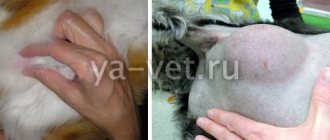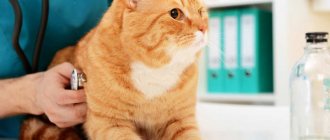Neoplasms on the body of cats require attention, as they can threaten the pet’s life. A hard lump on a cat’s neck may turn out to be an ordinary wen, which does not pose a danger if removed in a timely manner, but may also indicate the occurrence of malignant processes.
It is impossible to independently diagnose the nature of the neoplasm without a biopsy, so the first thing a loving owner should do when discovering a growth is to show the pet to a specialist.
Risk factors
In the vast majority of cases, owners of older animals encounter neoplasms on the withers and neck of cats. The appearance of soft cones and balls is due to the natural aging of the animal’s body. Risk factors for this:
- The pet is over 8 years old;
- Endocrine disorders;
- Obesity;
- Presence of parasites.
Only a veterinarian can accurately identify the nature of the lump, the cause of its appearance and suggest treatment methods. Self-medication in the presence of formations in pets is not allowed.
Treatment
Depending on the type of cone, the treatment is different:
- The wen opens on its own when it is “ripe”. A viscous substance is released from the hole after opening. You need to carefully squeeze out the contents and treat the wound with an antiseptic.
- The abscess is opened surgically and preferably under sterile conditions. If the inflammation is not opened, the abscess can burst and lead to infection of the entire animal’s body.
- In case of purulent lymphadenitis, the lump must be opened surgically and the wound must be sanitized. In the absence of pus, vitamin therapy is carried out, and physiotherapeutic procedures are prescribed. It is imperative to establish the cause of inflammation of the lymph nodes and first of all fight the cause of the underlying disease (for example, sore throat).
- Benign tumors and cysts are removed surgically if they cause discomfort and worsen the animal’s life. If the cyst is small or if the animal's condition does not allow surgery, the growth and development of the cysts is monitored.
- The tumor goes away on its own after vaccination; no special methods or treatments are required.
- Oncological tumors are treated only by surgery. Moreover, during the operation, not only the tumor, but also part of the healthy tissue is cut out in order to avoid further development of the tumor. Chemotherapy courses are being carried out.
Abscess on the neck
A lump on your cat's neck may be an abscess. This is a cavity filled with pus. It appears at the sites of wounds and injuries, and may be a consequence of skin irritation by parasites, in response to which the pet scratched the wound.
Abscess symptoms:
- Homogeneous structure of the neoplasm.
- Redness and increased temperature of the skin around the affected area.
- Pain when pressing.
With an abscess, the cat is constantly trying to reach the tumor. If she can't scratch her neck with her paw, she starts rubbing herself against the furniture. Thus, the animal tries to get rid of the annoying lump on its own.
Since an abscess is a purulent inflammation, a general deterioration in the pet’s well-being is possible. The cat may become lethargic or, on the contrary, irritated and refuse to be handled.
Only a veterinarian can quickly relieve an animal of discomfort. The abscess is opened with a scalpel, then the cavity filled with pus is cleaned out and the wound is treated with antiseptic. If necessary, the doctor may apply stitches and prescribe antibiotics to prevent the inflammation from reoccurring.
We recommend the article: Why does a cat not open one eye?
An abscess can open on its own, but this is dangerous for the animal’s health. The cat can lick off the purulent contents, but there remains a risk of re-infection of the resulting wound.
Associated symptoms
Apart from the presence of a lump under the skin, the animal may not show any other symptoms. Wen and benign neoplasms, as a rule, do not manifest themselves in any way.
In some cases, the tumor constantly increases in size, as a result a large lump grows and begins to interfere with the cat and cause inconvenience. In such cases, measures should be taken as soon as possible.
Firstly, the rapid growth of a tumor is a dangerous sign. And secondly, the cat will try to get rid of the irritating factor by scratching or trying to rip off the bump in some way. This can lead to aggravation of the pathological process, injury, and bleeding from the damaged area.
In some cases, when a cat develops a gradually enlarging lump under the skin, a number of additional symptoms are observed. Suppuration or an inflammatory process may be accompanied by hyperemia of the affected area, skin tension, swelling and severe pain. Also, due to the activity of pathogenic microflora, symptoms of intoxication increase: fever, weakness, and sometimes nausea and vomiting.
Allergic reactions can be accompanied by extremely unpleasant itching sensations for the cat. Itchy skin provokes scratching, damage to the skin and aggravation of the problem.
Lump on a cat's neck photo
Mastopathy
Mastopathy or mammary hyperplasia is a benign tumor. It gives the cat unpleasant and painful sensations. Represented by permanent changes in the mammary glands. These include neoplasms and other pathological processes.
Bumps on a cat's body are detected by palpation. They feel slightly elastic to the touch. There is a high probability of their occurrence in animals over 7 years of age.
Forms of the disease
Breast hyperplasia is divided into two forms:
- Diffuse mastopathy. Manifests itself with painful sensations before estrus. It feels like a bag of fine shot. Often goes into the next form.
- Fibrocystic mastopathy. The disease is represented by compacted nodules in the area of the mammary glands. They cause the cat discomfort and pain. Such bumps can form in a cat aged 10–16 years.
Causes
The appearance of the disease in cats is provoked by:
- mastitis is a common precursor;
- injury to the mammary glands;
- hormonal surges that were caused by estrus, pregnancy and nursing;
- prolonged stressful situations;
- feeding with low-quality feed;
- nematode larvae, which often live in the mammary glands.
Symptoms
The resulting mastopathy, which looks like a lump on a cat, manifests itself with the following symptoms:
- Colostrum discharge from the nipples mixed with blood or ichor.
- Pain in the mammary glands. They cause discomfort to the cat, which is noticeable by frequent licking.
- Enlarged glands. On palpation, fine granularity or veininess is felt.
- General deterioration in health. The cat loses its appetite and becomes very thirsty.
- Enlarged lymph nodes.
Important! In some cases, mastopathy manifests itself as ulcers, wounds and suppuration.
Diagnosis of pathology
If a cat has a lump in the lower abdomen, it is examined. It involves taking blood for biochemical and clinical analysis. Ultrasound and x-ray are recommended to exclude the presence of metastases in the abdominal cavity and lungs.
To determine the tumor group, a histological examination is performed. If mastopathy is confirmed, the veterinarian recommends a mastectomy, a surgical procedure to remove the affected glands.
Treatment and prevention
If a lump under the skin is detected at an early stage, homeopathic remedies and medications may be prescribed.
Important! There is an erroneous and even dangerous opinion that mammary hyperplasia can be treated with compresses. In fact, this leads to tumor degeneration.
In other cases, mastopathy is treated with mastectomy. The operation is performed by a surgeon. It involves removing the ball under the skin, the affected mammary glands and lymph nodes. Upon completion of the procedure, the animal is prescribed antibacterial therapy and special postoperative care.
Sterilizing the kitten before the onset of the first heat will allow you to 100% avoid mastopathy. Other activities are aimed at early detection of the disease. These include:
- visit the veterinarian 3–4 times a year;
- refusal of hormonal drugs to suppress estrus;
- selection of high-quality industrial feeds.
Malignant neoplasms
A soft lump on a pet's neck can pose a threat to the cat's life. In older animals, the appearance of a neoplasm may indicate oncology.
Malignant lumps do not have specific symptoms; only a specialist can make a diagnosis. As a rule, with cancer, a cat feels unwell and lacks strength, refuses to eat, and begins to lose weight. Since these symptoms are common to other diseases, you should immediately show the animal to a specialist.
To make a diagnosis, the doctor will do an X-ray or MRI. If a malignant tumor is suspected, a biopsy is performed - removal of particles of the tumor for the purpose of histological examination of tissue cells. Based on the results of histology, a decision is made on further treatment. The lump must be completely removed, and the animal is prescribed a course of chemotherapy.
Hormonal disorders and breast cancer
The second reason for the formation of lumps in a dog may be the development of a mammary tumor. Unlike mastopathy, tumors usually have focal localization. There are several causes of breast tumors. But the main predictive factors are the following: - constantly recurring estrus - long-term absence of mating during the reproductive period - hereditary factor - long-term use of hormonal drugs
Tumors on the mammary glands can be either benign or malignant. But the percentage of benign formations is very small. Thus, 9 out of 10 neoplasms on the mammary glands in cats are cancer. Tumors can be easily detected by simply palpating the surface of the mammary glands. You may notice the appearance of lumps and nodules in your dog, which may increase in size if no measures are taken. As a result, the tumor can grow and develop into a malignant pathological form.
At first, the tumor is usually quite small in size and rarely grows, but the tumor can abruptly move into the first stage of the disease after false pregnancy. The number and size of the bumps may increase, and the surface becomes bumpy.
If you trust statistics, then a common cause of death for most animals in the second half of life is oncology in cats and dogs . It firmly holds second place among the causes of overall mortality. However, as in humans, if a tumor and lump in a cat are detected in a timely manner, then surgical treatment in the early stages usually leads to a complete recovery. If you do not seek help from a veterinarian in time, the tumor will grow and cause complications. Enlarged lymph nodes may be noted. At the last stage, the tumor metastasizes to other organs. At this stage of the disease, the prognosis is unfavorable with any type of treatment. Frequently asked veterinarian questions
If a cat has a small and single lump near the nipple, should it be taken to the vet? Naturally. Even the smallest neoplasm can become the beginning of a malignant tumor. It is easiest to take action at the onset of the disease.
If the mammary gland is swollen over the entire surface, but the cat feels well and eats, then should you worry? Swelling may be a sign of an unfavorable process. To find out exactly the nature of the process, you need to contact a veterinary clinic.
The cat has lumps all over the mammary gland. The doctor suggested removing the entire gland. Is this dangerous for the dog? There are no simple operations. Especially oncological ones. The intervention proposed to you should be carried out by a veterinarian with experience in such interventions. After surgery, a histological examination is required. And, if necessary, adjuvant chemotherapy.
Incipient breast tumor.
Developed breast tumor.
As soon as a lump has been detected in a cat or dog, or if there are indirect signs that allow one to suspect cancer, we recommend that you consult a veterinarian without the slightest delay.
Unfortunately, this problem cannot be solved at home. We have all the necessary conditions for the examination and treatment of cancer in dogs and cats.
Breast tumor. Despite its small size, this is already a neglected case. Metastases.
Lipomas in cats
If a cat has a soft lump on its neck that easily rolls under your fingers and does not cause discomfort to the pet, a lipoma or wen is a possible cause.
The reason for the appearance of such seals is the peculiarity of the functioning of the animal’s sebaceous glands. The formation of lipomas is often associated with endocrine disorders and obesity in older animals.
Wen themselves are not dangerous, but must be removed, especially if they are located on the pet’s neck or head. The fact is that a benign lipoma can begin to degenerate into cancer with age, so veterinarians recommend removing lipomas in a timely manner.
How long do cats with tumors live?
Unfortunately, no doctor in the world can give an accurate prognosis; it depends on many factors, as well as on how aggressively the tumor develops. It happens that, despite all the efforts made by the owner, the animal dies after a month. This could be due to a variety of factors. Starting from inappropriate treatment and ending with actively growing metastases. Try to regularly donate blood for analysis and carry out all the tests that the doctor prescribes for your pet. If he is scheduled for another study, this does not mean that they want to scam you out of money. The doctor wants to help the pet and does everything in his power. And without traditional research it is almost impossible to do this, because a visual inspection alone is not enough. We still need to examine the animal and do everything to ensure that the treatment matches the disease. Be attentive to your pets and take them for a preventive examination at YA-VET!











